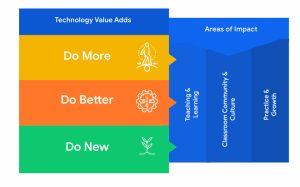
Do More, Do Better, Do New with EdTech
04/18/2023

What Should EdTech Help You Do?
Technology is becoming more prevalent than ever in our lives. With advances in AI, virtual classrooms, and personal devices, it’s no wonder that there are over 8,000 verified tools in the edtech marketplace. Teachers and students are estimated to use over 140 individual tools per year.
With so many EdTech tools, how do you know you are making choices that will benefit your school, classroom, and students? Leading Educators developed the Value Add of Technology on Teaching Framework (VATT) in partnership with Google for Education and education experts from around the globe to help educators address that question.
Introducing the Value Add of Technology on Teaching (VATT) Framework

There are many reasons why teachers seek out educational technology. Often it comes down to three core goals: gaining capacity or improving efficiency, becoming more effective at meeting different student needs, and expanding possibilities within the classroom. That’s where the VATT comes in.
We designed the VATT framework as a practice tool to help teachers and school system leaders like you build upon your instructional goals with edtech and monitor how well a tech-enhanced practice is working. It also helps you reflect on how well a piece of technology serves your overall goals or if questions about its application still need to be answered.
Do More, Do Better, Do New
The VATT is anchored to three progressive value adds: do more, do better, and do new. These represent a progression of enhancement grounded in everyday challenges and opportunities educators face in instruction.
- Do More: Teachers desire more capacity. Technology tools and platforms’ organizing and processing capabilities can provide unparalleled efficiency in completing tasks, organizing and retrieving data, and sharing information. If technology can add or stabilize capacity in one area, it provides a critical lever and enabler in increasing the effectiveness of another.
- Do Better: Best practices in technology-enhanced teaching can enable better student learning outcomes as they are comprehensively diagnostic, individually adaptable, and immediately responsive. In addition, teachers can access clearly defined learning analytics to support their reflective practices.
- Do New: Best practices in technology-enhanced teaching have the power to enable better learning outcomes for students as they can be comprehensively diagnostic, individually adaptable, and immediately responsive. In addition, teachers can access clearly defined learning analytics to support their own reflective practices.
We hope to inspire reflection on how using technology might support or add value to someone’s practice, not evaluate specific tools. Sometimes the technology we use is great, but we may not see its full potential because we’re using tools for a practice that’s not best suited for its design.
What Makes VATT Different from Existing Frameworks?
There’s no shortage of frameworks for edtech integration in instruction including SAMR, the ISTE standards, and TPACK. The VATT is meant to build upon their best parts to provide a more holistic, contextualized, and teacher-centered perspective.
- SAMR focuses on tech integration at the task level.
- TPACK focuses on what teachers need to know (tech, pedagogy, content).
- The ISTE Standards for Teachers focus on what teachers need to be (i.e. learner, leader, designer, facilitator, etc) and how to act accordingly.
We aim to empower educators to reach the space where technology can be adapted and deployed for the greatest impact in instruction, according to them, their students, and the field more broadly. Effective tech-enabled instruction will likely require a blend of all of these frameworks plus instructional frameworks.
Take Action
You can use the framework to collect data intentionally about how the tools you use impact your practice.
For example, a practitioner can focus on the Classroom and Culture section of the framework and intentionally use tools that will enhance their ability to foster positive collaborative relationships with students. Along the way, they can collect data about how their practice improves or positively affects student experience when enhanced with technology.
The use of technology is only going to grow in our school systems. Using the VATT framework has the potential to directly impact teacher practice, which affects the student experience. Let’s approach technology with the same thoughtfulness and reflection used in other classroom areas to increase access to a just and fair education for all students.
Visit valueedtech.org to get your free copy!







